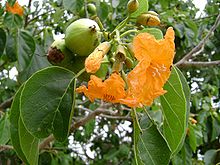Cordia subcordata
| Cordia subcordata | |
|---|---|
 |
|
| flower, fruit | |
| Scientific classification | |
| Kingdom: | Plantae |
| (unranked): | Angiosperms |
| (unranked): | Eudicots |
| (unranked): | Asterids |
| Order: | (unplaced) |
| Family: | Boraginaceae |
| Genus: | Cordia |
| Species: | C. subcordata |
| Binomial name | |
|
Cordia subcordata Lam. |
|
Cordia subcordata is a species of flowering tree in the borage family, Boraginaceae, that occurs in eastern Africa, South Asia, Southeast Asia, northern Australia and the Pacific Islands. The plant is known by a variety of names including Mareer, Kerosene wood, Manjak, Snottygobbles, Glueberry, Narrow-leafed Bird Lime Tree, "Kanawa," Tou, and Kou. In Java and Madura, it is known as Kalimasada, Purnamasada, or Pramasada; Javanese folklore consider the tree to contain spiritual power.
C. subcordata grows to 7–10 m (23–33 ft) at maturity, but may be as tall as 15 m (49 ft). It has ovate leaves that are 8–20 cm (3.1–7.9 in) and 5–13 cm (2.0–5.1 in) wide.
The tubular flowers of C. subcordata are 2.5–4 cm (0.98–1.57 in) in diameter and form cymes or panicles.Petals are orange and the sepals are pale green. Blooming occurs throughout the year, but most flowers are produced in the spring.
C. subcordata produces fruit year round. They are spherical, 2–3 cm (0.79–1.18 in) long, and woody when mature. Each fruit contains four or fewer seeds that are 10–13 mm (0.39–0.51 in) long. The fruit are buoyant and may be carried long distances by ocean currents.
C. subcordata is a tree of the coasts, found at elevations from sea level to 30 m (98 ft), but may grow at up to 150 m (490 ft). It grows in areas that receive 1,000–4,000 mm (39–157 in) of annual rainfall. C. subcordata prefers neutral to alkaline soils (pH of 6.1 to 7.4), such as those originating from basalt, limestone, clay, or sand. Allowable soil textures include sand, sandy loam, loam, sandy clay loam, sandy clay, clay loam, and clay.
...
Wikipedia

